Using the MIB Browser
This section acquaints you with using the MIB Browser to manage SNMP-manageable nodes.
This section includes the following topics:
- Browsing the MIB Tree
- Viewing the Values of an Object and Its Child Nodes
- Configuring a Node by Setting Object Values
- Modifying SNMP Preferences
- Modifying Instances of an SNMP Table
- Forming Tables of Scalar Objects
- Graphing SNMP Request Results
- Using a Profile for Tables and Graphs
Browsing the MIB Tree
The MIB Browser lets you select the objects you want to display, and it sends SNMP queries to the node to obtain the data objects that you requested. It also allows SNMP operations such as GET, GETNEXT, and SET requests on a particular object in the MIB of an SNMP-managed node.
The MIB Browser periodically polls the node and continually updates the display. You can view and modify scalar and tabular data objects.
MIB Tree Browser
Within the MIB browser, the MIB Tree Browser is a graphical display of management data that consists of numerous objects.
The MIB Browser displays a composite OID tree for all compiled MIBs. Analogous to a file system, the MIB Browser shows leaf objects, which are the SNMP data objects.
The MIB Browser spans the selected node with its subtree and leaf objects and displays the name of the objects in the MIB Tree Browser. You browse from the highest level of the tree and view the leaf object values.
The top pane of the MIB Tree Browser displays the tree with the selected object. Each object is displayed as a file folder icon, followed by its SNMP name with the SubId appended in parentheses. If the object is a non-leaf node, the MIB Tree Browser also displays its children.
The bottom pane describes the selected object. The description is derived from the compiled MIB file. The format of the description is as follows: textual description of the object, full numeric OID and object name, ASN.1 type, size, textual convention, access, Index clause taken from the Entry object, status, and description.
For example, for an internal node SYSTEM with child nodes, the child nodes describe the properties of the SYSTEM. The OID of SYSTEM is iso(1).org(3).dod(6).internet(1).mgmt(2).mib-2(1).system(1). Another equivalent representation of this OID is 1.3.6.1.2.1.1. Note that the parent node does not have information, and the child nodes contain the properties.
The child nodes of SYSTEM are sysDescr OID(1.3.6.1.2.1.1.1), sysObjectID OID(1.3.6.1.2.1.1.2), sysUpTime OID(1.3.6.1.2.1.1.3), sysContact OID(1.3.6.1.2.1.1.4), sysName OID(1.3.6.1.2.1.1.5), sysLocation OID(1.3.6.1.2.1.1.6), and sysServices OID(1.3.6.1.2.1.1.7).
The following figure shows the MIB Browser window:
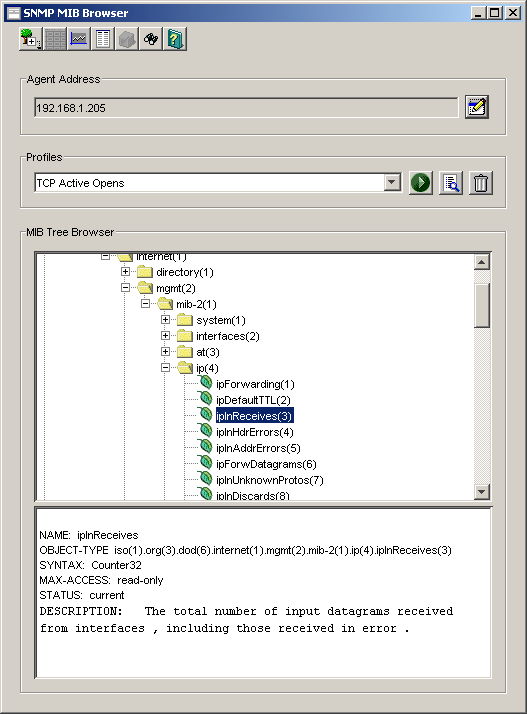
To browse the MIB objects:
-
In Novell ConsoleOne, click the target SNMP-manageable node.
-
Click File > Action > MIB Browser.
-
Click the object whose values you want to view from the MIB Tree Browser.
- To select an object, click the name text or the icon in the MIB Browser tree.
- To expand or collapse the next level in the tree display, double-click the object.
Viewing the Values of an Object and Its Child Nodes
The MIB Browser spans the selected node with its subtree and leaf objects and displays its values in the TreeWalk Query Results window. You can browse the OID values of scalar and tabular objects.
To view the values of the instances of a MIB object:
-
In Novell ConsoleOne, click the target SNMP-manageable node.
-
Click File > Action > MIB Browser.
-
Click the object, then Perform TreeWalk for the node button.
The following figure shows the TreeWalk Query Results window:
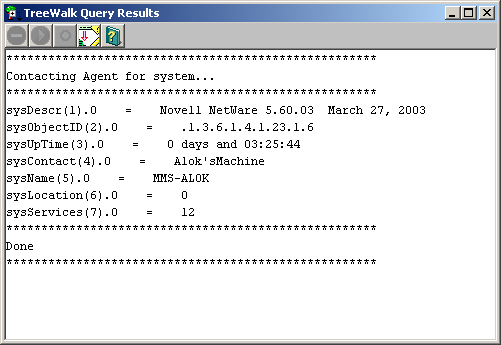
If you select a leaf object, you can view the values for each instance of this object. For non-leaf objects, this window will display all the values of the child node of this object. For example, if you want to view the values of the child nodes for the object system, click the parent object system.
The display process in the Treewalk Query Results window continues recursively for all the non-leaf objects of the selected object.You can pause and resume this display in the window.
Customizing the Display of TreeWalk Query Results Window
The TreeWalk Query Results window displays the number of lines based on the settings specified in the treewalk.properties file.
This file, located in \novell consoleone\version\bin\saved-views\generic directory, contains the following setting: MaximumNumberofLine=number_of_lines_for_display
where number_of_lines_for_display is the number of lines that will be displayed at a time. The default setting is 10,000 lines.You can modify this setting. The settings will apply only if you restart Novell ConsoleOne and bring up the TreeWalk Query Results window.To clear the display in the TreeWalk Query Results window when the text buffer is full, click the Clear button. There may be some out of memory problems if you specify a large line setting in the treewalk.properties file.
Configuring a Node by Setting Object Values
Using the MIB Browser, you can issue an SNMP SET command to change information at an SNMP-manageable node if you have the appropriate privileges. You select a scalar object from the MIB Browser and set its value.
You can modify the values for an integer, enumerated integer, object identifier, string, and IP address object types.
To issue an SNMP SET command for a scalar object:
-
In Novell ConsoleOne, click the target SNMP-manageable node.
-
Click File > Action > MIB Browser.
-
Click a scalar object whose values you want to view, then click Display Data As a Scalar Table.
-
Specify the object value for the scalar object.
-
Click OK.
To modify columnar values of an SNMP table, see Modifying Instances of an SNMP Table.
Modifying SNMP Preferences
SNMP parameters are used to communicate with the target device. The MIB Browser lets you change the SNMP community strings or specify the transport address of a new target device.
Any SNMP operation requires these values to be set. After starting an SNMP operation, such as polling a table, changing the SNMP preferences does not affect the operation.
You can modify the following parameters:
Agent Address: You can specify the IP or internal IPX address and the Domain Name System (DNS) name of the SNMP-manageable node to which you want to send an SNMP request. This node should have an SNMP agent.
SET and GET Community Strings: The community string that Novell ZENworks Server Management uses must match the one expected by the SNMP agent in the managed node or the SNMP operations will fail. If the SNMP agent on the node expects a community string for SET and GET operations that is different from public (the default), you can specify the expected community string to override the default community or those community strings you set previously. You can use Unicode* or International characters for the community string.
To modify the SNMP preferences:
Modifying Instances of an SNMP Table
A table in an SNMP MIB is an SNMP construct derived from the structure of the MIB. Each row in the table corresponds to a row in the SNMP table.
The MIB Browser provides the Table Display window to display tabular objects you select. This window displays one or more rows from an SNMP table in a two-dimensional grid and follows the SNMP index order to display rows.
The table shows each column in the SNMP table as columns. Each column heading is derived from the SNMP table columns. The Table Display window displays the columns with their values as single or multiple rows for the MIB you selected.
SNMP allows operations on individual table entries only. The OID identifies the column and row.
From the MIB Browser, you can perform the following operations:
- Add rows to an SNMP table
For more information, see Adding Rows to an SNMP Table.
- Modify a row of an editable table
For more information about adding or modifying rows, see Adding Rows to an SNMP Table.
- Save the table as a profile
For more information about saving a table as a profile, see Using a Profile for Tables and Graphs.
Viewing the SNMP Table
To view the SNMP table:
-
In Novell ConsoleOne, click the target SNMP-manageable node.
-
Click File > Action > SNMP MIB Browser.
-
Click a tabular object whose values you want to view, then Display Data As a Table.
From the Table Display window, you can add rows or modify the rows of the SNMP table and input values for each column. For more information about adding or modifying rows of an SNMP table, see Adding Rows to an SNMP Table.
The following figure shows the MIB Browser Table Display window.
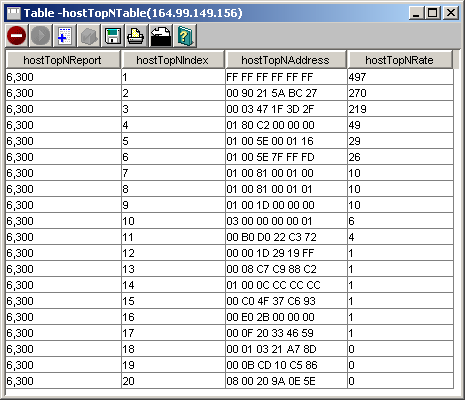
The MIB Browser periodically sends SNMP queries to the node to obtain the data objects you request. When you provide new values for writable objects, the MIB Browser writes these values to the node. The MIB Browser periodically polls the node and continually updates the display. You can change the polling interval by suspending the SNMP interaction or by canceling the SNMP interaction.
Adding Rows to an SNMP Table
When you add a new row to an SNMP Table, the MIB Browser generates the SNMP SET request.
Before generating the SNMP Set request, the MIB Browser sends a GET command to the node that you selected in the MIB Browser table and retrieves the value of the object. On adding rows with the specified values for the objects, the MIB Browser issues multiple SNMP SET commands to update the SNMP table.
To add a row to an SNMP table:
-
Click the table object from the MIB Browser window, then Add a New Row to the Table.
For more information about selecting the table object, see Modifying Instances of an SNMP Table.
The following figure shows the Add Row to Table window.
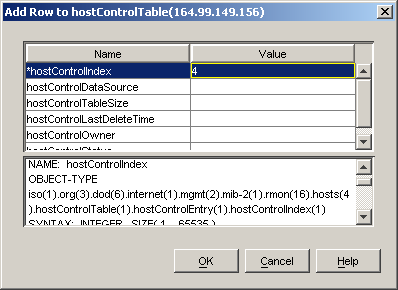
-
Double-click the row.
-
Modify the value then click OK, and then click OK.
To add rows in an SNMP table, you must input the values for all the index rows, which are denoted by asterisks.
To modify a row of an editable table:
Forming Tables of Scalar Objects
You can make a scalar table by combining the scalar objects from the MIB Browser. A scalar table is a two-column table with the name and value of the scalar object entries. To create a scalar table, you select a group node with scalar child nodes or a group of scalar objects. For example, you add one or more scalar objects such as ipInDelivers and SysUpTime to make a new scalar table labeled ipInDeliversTable.
If you want to view the scalar tables that you create, save the scalar table as a profile. You can load the scalar table profiles when required.
The following figure shows the Scalar Table window:
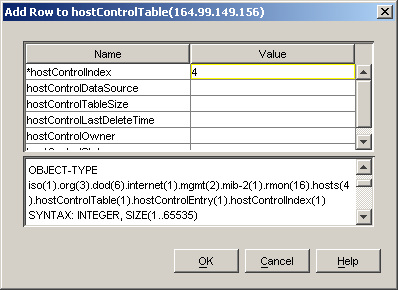
To combine scalar objects as a scalar table and view the table:
-
Create a new scalar table.
-
Add to or modify the existing table by adding scalar entries or by removing entries from the table.
-
Save the scalar table as a profile.
-
Launch the profile.
To create a new scalar table:
-
In Novell ConsoleOne, click the target SNMP-manageable node.
-
Click File > Action > SNMP MIB Browser.
-
Right-click a scalar group or a scalar object then click New, and then click Scalar Table.
To add or remove scalar entries to an existing table:
-
Open an existing scalar table.
-
Toggle to the MIB Browser window then click Add to, and then click Scalar_table_name.
Alternatively, click the scalar entry in the MIB Browser window, and from the Scalar Table window, click Add Node Selected from Browser Window.
To remove the scalar entry, click the scalar entry in the Scalar Table window, and click Remove the Node Selected in This Window.
Graphing SNMP Request Results
You can plot the SNMP request results in a graph that displays the polled data of the MIB objects. Only attributes of ASN.1 type Integer, Counter, Time Ticker, and Unsigned Integer are plotted as current absolute values.
You can plot more than one object in the same graph, add more objects, or remove the MIB objects from the existing graph. If you want to view the graphs that you create, save the graph as a profile. You can then load the graph profiles when required.
To graph SNMP request results of one or more nodes:
-
Click the target SNMP-manageable node from the console.
-
Click File > Action > SNMP MIB Browser.
-
Click the MIB object whose values you want to plot.
-
Right-click the object then click New, and then click Graph.
The MIB Browser plots the graph with the values of the selected object and its leaf object values dynamically in the Graph pane of the window.
The following figure shows the Graph window.
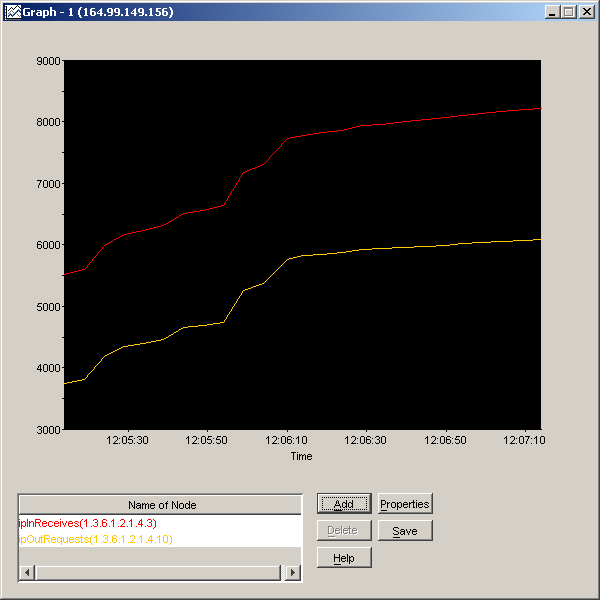
To graphically plot the values of more than one object:
-
Toggle to the MIB Browser window.
-
Click the MIB object you want to plot then click Add To, and then click the Graph.
You add these objects to any of the active graph windows you want.
Alternatively, you can click the MIB object from the MIB Browser window and then click the Add button in the MIB Browser Graph. Remove the objects from the list that you do not want by selecting the node from the list and clicking the Delete button.
From the Graph window, you can perform the following operations:
- Rescale the Y-axis of the graph
- Set the period to display
- Set the polling interval and refresh rate of the display
By default, the values plotted in the graph are absolute. If you want to view the rate of change of values per second with respect to sysUpTime, you must click the Rate option. For example, if you click ipInPackets and choose the Rate option, you can view the values per second.
Using a Profile for Tables and Graphs
A profile contains information about the properties of the graph, table, or scalar table. You use a profile to specify the information, such as the method of display (table or graph) and polling interval.
You create a profile by saving the properties of the table, scalar table, or graph as a profile. You open the profile to view a table, scalar table, or graph of different SNMP-manageable nodes on the segment with the same properties specified in the profile. You can modify or delete the profile.
To form a profile:
-
Save the properties of the display window.
-
Open the profile.
-
Modify the properties of the profile as required.
To save a profile:
-
Click the Save button from the Scalar table window, Graph window, or Table window.
-
Enter the details of the profile.
Specify the name, description, and properties of the objects.
-
Click OK.
To open a profile:
-
From the MIB Browser window, click the profile you want from the drop-down list.
-
Click Launch This Profile.
To modify the selected profile:
To delete a selected profile: